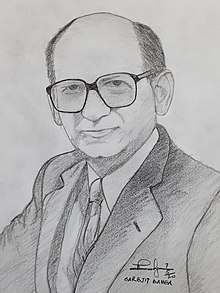Otto Königsberger
Otto H. Königsberger (13 October 1908 – 3 January 1999) was a German architect who worked mainly in urban development planning in Africa, Asia and Latin America, with the United Nations.[2][3][4]

Otto Königsberger | |
|---|---|
| Born | October 13, 1908 |
| Died | January 3, 1999 (aged 90) |
| Nationality | German, Indian[1] |
| Occupation | Architect |
| Known for | Architecture, Urban planning |
Early life
Königsberger was born in Berlin in 1908, and trained as an architect there at the Technical University, graduating in 1931. In 1933, he won the Schinkel Prize for Architecture[5] for a design for the Olympic Stadium in Berlin. However, with the rise to power of the Nazi Party, Königsberger was forced to leave the country, as was his uncle, physicist Max Born. Königsberger later illustrated Born's popularized physics text, The Restless Universe (published 1935).[6]
Königsberger spent the next six years in the Swiss Institute for the History of Egyptian Architecture in Cairo, where he gained his doctorate. When his uncle Max Born was in Bangalore as a guest of C. V. Raman, the Diwan Mirza Ismail enquired if he know of any trained architect. Thanks to Born's introduction, Königsberger was appointed chief architect and planner to Mysore State, India in 1939. His buildings during this period include some buildings in the Indian Institute of Science (1943–44), the Tata Institute of Fundamental Research (TIFR) in Bombay (Mumbai), the bus station, Serum Institute and Victory Hall (1946, renamed as Town Hall) in Bangalore, the town plan for Bhubaneswar, and some town planning for Jamshedpur with the vision of J.R.D. Tata. After Indian Independence he became director of housing for the Indian Ministry of Health from 1948 to 1951, working on resettling those displaced by partition.[7]
Career
In 1953 Königsberger moved to London and became head of the Department of Development and Tropical Studies at the Architectural Association, which later became the Development Planning Unit of University College, London, where he worked as a professor until his retirement in 1978.
Königsberger taught that town planners in the developing world should be prepared to dynamically adapt their plans, and involve local communities and techniques, as opposed to imposing a static master plan based on Western ideas – an approach he called Action Planning. He served as a senior adviser to the United Nations Economic and Social Council from the 1950s, and helped launch Habitat International[8] in 1976, which he edited until 1978. His Manual of tropical housing and building[9] was published in several languages and remains a standard course text in many parts of the world.
Awards and legacy
In 1989, Königsberger was one of the first recipients of the UN Habitat Scroll of Honour, the most prestigious award given by the United Nations in recognition of work carried out in the field of human settlements development.[10][11] The same year, University College London established the Otto Koenigsberger Scholarship[12] to enable young professionals from developing countries to study urban planning in the UK.
See also
Bibliography
- Abrams, Charles; United Nations. (1959). A housing program for the Philippine Islands. New York: United Nations Technical Assistance Administration.
- Koenigsberger, Otto H.; Steven Groák (1981). A Review of Land Policies. Pergamon Press. p. 200. ISBN 978-0-08-026078-5.
- Koenigsberger, Otto H.; Carl Mahoney; Martin Evans (1971). Climate and House Design. United Nations. p. 93.
- Koenigsberger, Otto H.; S. Groak (1978). Essays in Memory of Duccio Turin, 1926-1976: Construction and Economic. Pergamon Press. p. 204. ISBN 978-0-08-021844-1.
- Bernstein, Beverly; International Urbanization Survey. (1973). Infrastructure problems of the cities of developing countries. New York: International Urbanization Survey, Ford Foundation.
- Koenigsberger, Otto; Tata Iron and Steel Company (1945). Jamshedpur development plan. Bombay: Printed by S. Ramu at the Commercial printing press.
- Koenigsberger, Otto (1952). "New towns in India". Town Planning Review. 23 (2): 95–131. doi:10.3828/tpr.23.2.cpn33402758n8446. ISSN 0041-0020.
- Koenigsberger, Otto H.; Robert Lynn (1965). Roofs in the Warm Humid Tropics. Published for the Architectural Association by Lund, Humphries. p. 56.
- Koenigsberger, Otto; Nations Unies. (1975). The absorption of newcomers in the cities of Developing countries. New York: United Nations.
- Koenigsberger, Otto (1971-02-01). "The City in Newly Developing Countries". Urban Studies. 8 (1): 75–76. doi:10.1080/00420987120080111. ISSN 0042-0980.
- Koenigsberger, Otto H.; Charles Abrams; Steven Groák; Beverly Bernstein (1981). The Work of Charles Abrams: Housing and Urban Renewal in the USA and the. Pergamon Press. p. 268. ISBN 978-0-08-026111-9.
- Lee, Rachel (2012). "Constructing a Shared Vision: Otto Koenigsberger and Tata & Sons". ABE Journal European Architecture Beyond Europe. 2.
References
- https://scroll.in/magazine/881630/when-a-pioneering-german-architect-was-bullied-by-the-media-and-parliament-into-leaving-india
- Patrick Wakely (1999-01-26). "Cities of light from slums of darkness". London: The Guardian. Retrieved 2008-02-09.
- "Otto Konigsberger (1908-1999)". 2007-06-19. Archived from the original on 2008-01-08. Retrieved 2008-02-08.
- Dennis Sharp (1999-01-13). "Obituary: Otto Konigsberger". Retrieved 2008-02-10.
- A prize awarded by Architekten- und Ingenieur-Verein zu Berlin (Architecture and Engineering Office of Berlin) since 1852. "Architekten- und Ingenieursverein zu Berlin". 2007-01-30. Archived from the original on 2007-10-07. Retrieved 2008-02-09.
- Born, Max (1951). The Restless Universe. Dover Publications. p. 315. ISBN 978-0-486-20412-3.; originally published by Blackie and Son Limited, 1935.
- Kalia, Ravi (2004). Gandhinagar: Building National Identity in Postcolonial India. Univ of South Carolina Press. p. 165. ISBN 978-1-57003-544-9.
- "Habitat International". Elsevier. 2008-02-10. Retrieved 2008-02-10.
A Journal for the Study of Human Settlements, Established at the UN Habitat Conference, Vancouver, 1976
- Koenigsberger, Otto (1980). Manual of tropical housing and building : climatic design. London: Longman.
- "UN-HABITAT Scroll of Honour Award Winners". 2008-02-10. Archived from the original on 2009-08-01. Retrieved 2008-02-10.
- James Mugambi (2005-10-28). "UN HABITAT announces the 2007 Scroll of Honour Award Winners". Archived from the original on 2007-10-27. Retrieved 2008-02-10.
- "Scholarships and Funding". University College London. Retrieved 3 March 2013.